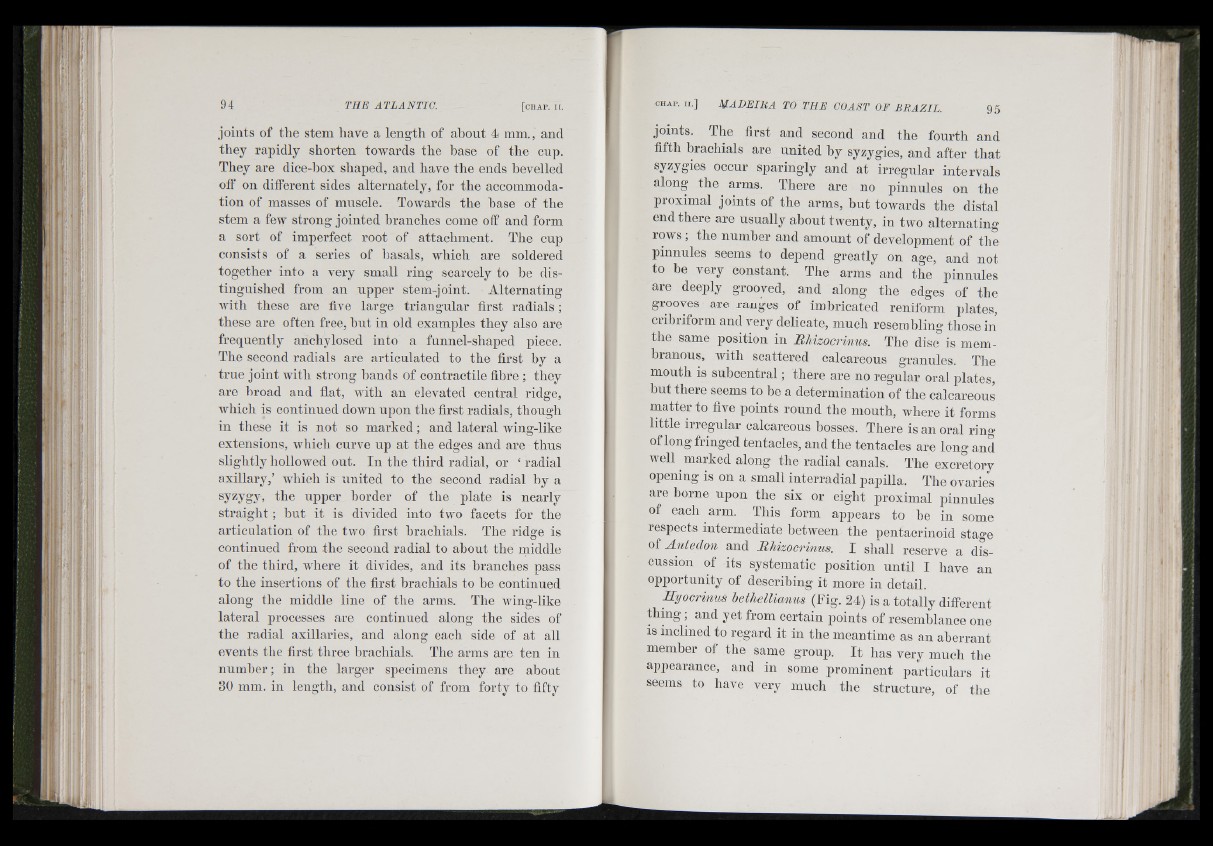
le: s "
A I
i- i'
joints of the stem have a length of about 4 mm., and
they rapidly shorten towards the base of the cup.
They are dice-box shaped, and have the ends bevelled
off on different sides alternately, for the accommodation
of masses of muscle. Towards the base of the
stem a few strong jointed branches come off and form
a sort of imperfect root of attachment. The cup
consists of a series of hasals, which are soldered
together into a very small ring scarcely to be distinguished
from an upper stem-joint. Alternating
with these are five large triangular first radials;
these are often free, but in old examples they also are
frequently anchylosed into a funnel-shaped piece.
The second radials are articulated to the first by a
true joint with strong hands of contractile fibre ; they
are broad and flat, with an elevated central ridge,
which is continued down upon the first radials, though
in these it is not so marked; and lateral wing-like
extensions, which curve np at the edges and are thus
slightly hollowed ont. In the third radial, or ‘ radial
axillary,’ wbicli is united to the second radial by a
syzygy, the upper border of the plate is nearly
straight ; but it is divided into two facets for the
articulation of the two first brachials. Tbe ridge is
continued from the second radial to about the middle
of the third, wffiere it divides, and its branches pass
to the insertions of the first brachials to be continued
along the middle line of the arms. The wing-like
lateral processes are continued along the sides of
the radial axillaries, and along each side of at all
events tbe first three brachials. The arms are ten in
number; in the larger specimens they are about
30 ram. in length, and consist of from forty to fifty
joints. The first and second and the fourth and
fifth brachials are united by syzygies, and after that
syzygies occur sparingly and at irregular intervals
along the arms. There are no pinnules on the
proximal joints of the arms, but towards the distal
end there are usually about twenty, in two alternating
rows; the number and amount of development of the
pinnules seems to depend greatly on age, and not
to be very constant. The arms and the pinnules
are deeply grooved, and along the edges of the
grooves are ranges of imbricated reniform plates,
cribriform and very delicate, much reserahling those in
the same position in Bhizocrinus. The disc is mem-
hranous, with scattered calcareous granules. The
mouth is subcentral; there are no regular oral plates,
but there seems to be a determination of the calcareous
matter to five points round the mouth, where it forms
little irregular calcareous bosses. There is an oral ring
of long fringed tentacles, and the tentacles are long and
well marked along the radial canals. The excretory
opening is on a small interradial papilla. The ovaries
are bonie upon the six or eight proximal pinnules
of each arm. This form appears to he in some
respects intermediate between the pentacrinoid stage
ofAntedon and Bhizocrinus. I shall reserve a dfs-
cussion of its systematic position until I have an
opportunity of describing it more in detail.
Ilyocrinus bethellianus (Tig. 24) is a totally different
thing; and yet from certain points of resemblance one
is inclined to regard it in the meantime as an aherrant
member of the same group. It has very much tbe
appearance, and in some prominent particulars it
seems to have very much the structure, of the